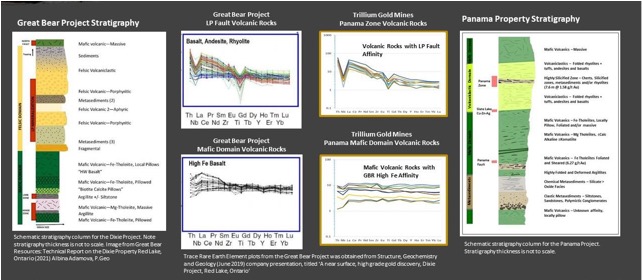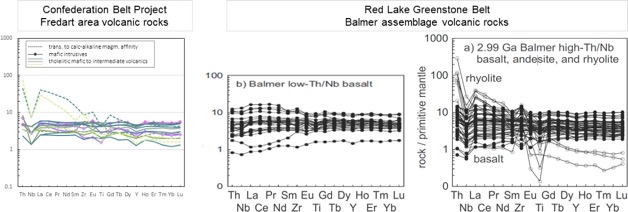Trillium Gold’s Field Work on Confederation Belt Reveals Strong Affinity to Red Lake’s Major Structural Trends
May 18, 2023
- A newly discovered spatial relationship of Balmer affinity rocks on Trillium’s Confederation Belt suggests the Cochenour-Gullrock Trend and associated unconformity continues from Red Lake across the northern portion of the Confederation Belt.
- Consistent anomalous to high-grade gold results spatially associated with these structures have allowed the Company to refine and develop meaningful high- priority drill targets.
- Historical gold mineralization (e.g., 1.58 g/t over 7.6 m, and 13.33 g/t Au grab sample from Panama Zone) occurs within similar rock types, stratigraphy, and along the Panama Lake North Trend, a possible extension or splay of Kinross Gold’s LP Fault.
- Primitive-mantle normalized trace element plots illustrate similarities between the Great Bear project and the Panama Lake property, suggesting high potential for gold discovery.
- Core photos from the Panama Lake property show remarkable textural and geochemical resemblance to Kinross Gold’s Great Bear project.
Vancouver, BC, Canada – May 18, 2023 – Trillium Gold Mines Inc., (TSXV: TGM, OTCQX:TGLDF, FRA:0702) (“Trillium Gold” or the “Company”) is pleased to provide an update from the lithogeochemistry, structural and stratigraphic studies over its approximate 570 sq km Confederation Belt project in Red Lake, Ontario. The project encompasses one of the largest contiguous land positions ever assembled in the Red Lake mining district, bound by the same geological trends that have defined the Red Lake Mining District as a world-class mining jurisdiction.
The results from the Company’s field work strongly suggest structural, stratigraphic, and litho- geochemical similarities along or adjacent to the eastern extensions of both the LP Fault, associated with Kinross Gold’s Great Bear project, and the Cochenour-Gullrock Fault, associated with Evolution Mining’s Red Lake Mine (Fig. 1).
“Viewed in conjunction with the resampling of historical core for gold, the technical findings from the field work add degrees of confidence supporting Trillium’s exploration model that these significant gold-bearing structures continue through the Confederation Belt property”, remarked Russell Starr, President & CEO of Trillium Gold. “Moreover, the consistency in the anomalous to high-grade gold
occurrences spatially associated with these structures have also opened up opportunities to refine and develop meaningful high-priority drill targets.”
To the southeast on the Panama Lake property, trace element lithogeochemistry has identified strong similarities between the metavolcanic rocks from the Panama Zone with the Felsic Domain of the Great Bear project. The mafic volcanic rocks also show a strong similarity to high-Fe basaltic rocks from the Great Bear project’s Mafic Domain (Fig. 2). Primitive-mantle normalized trace element plots illustrate similarities between the Great Bear project and the Panama Lake property, suggesting high potential for gold discovery.
Trillium’s re-logging of historical core of the Panama Zone from mid-2022 through to early 2023 shows remarkable textural similarities to core seen at the Great Bear project (Fig. 3). The Panama Zone historical gold mineralization (e.g., 1.58 g/t Au over 7.6 m, and 13.33 g/t Au grab sample) occurs within similar rock types and stratigraphic horizon along the Panama Fault North Trend, a potential eastern extension or splay of the LP Fault.
An airborne electromagnetic lineament coincident with the gold-bearing Panama Zone shows the Panama Zone and Panama Fault North Trend continuing to the northeast where recently completed enzyme leach soil surveys identified multiple overlapping anomalies for arsenic, nickel, zinc, silver, and chromium (Fig. 4). Arsenic in soil is a strong pathfinder candidate for gold mineralization based on historical geochemistry work performed on drill holes completed by Benton Resources in 2019 and a baseline soil line completed over the Panama Zone by Trillium in 2022.
In the central part of the Confederation Belt project along the Cochenour-Gullrock (Red Lake Mine) Trend, trace element analyses in mafic volcanics and associated rocks from historical drill core have identified similarities between Red Lake-associated Balmer assemblage volcanic rocks (Fig. 5). This newly discovered spatial relationship of Balmer affinity rocks adjacent to Confederation assemblage rocks suggests that the Cochenour-Gullrock Trend and associated unconformity continues from Red Lake across the northern portion of Trillium’s Confederation Belt project (Fig. 1). Gold results of up to 0.99 g/t in recently analyzed historical core, and up to 1.56 g/t from historic assays, occur proximal to the Cochenour-Gullrock Trend and to the unconformity over several kilometres (Fig. 1) as reported in Trillium’s news release of February 7, 2023 (please refer to the Company’s website at www.trilliumgold.com).
The technical information presented in this news release has been reviewed and approved by Samuel Lewis, P.Geo of Trillium Gold Mines Inc., as defined by NI 43-101.
On behalf of the Board of Directors, Trillium Gold Mines Inc.
Russell Starr
President & CEO, Director
For further information, please contact Donna Yoshimatsu, VP Corporate Development and Investor Relations at dyoshimatsu@trilliumgold.com, (416) 722-2456, or info@trilliumgold.com.
Visit our website at www.trilliumgold.com.
About Trillium Gold Mines Inc.
Trillium Gold Mines Inc. is a growth focused company engaged in the business of acquisition, exploration and development of mineral properties located in the Red Lake Mining District of Northern Ontario. As part of its regional-scale consolidation strategy, the Company has assembled one of the largest prospective land packages in and around the Red Lake mining district in proximity
to major mines and deposits, as well as along the Confederation Lake and Birch-Uchi greenstone belts. In 2022 the Company closed a number of acquisitions effectively extending its contiguous land position over more than 100 km of favourable structures on trend with Kinross Gold’s Great Bear project and Evolution Mining’s Red Lake Operation. In addition, the Company has interests in highly prospective properties in Larder Lake, Ontario.
Neither TSX Venture Exchange nor its Regulation Services Provider (as that term is defined in the policies of the TSX Venture Exchange) accepts responsibility for the adequacy or accuracy of this release.
Cautionary note regarding forward-looking statements
This news release contains forward-looking information, which involves known and unknown risks, uncertainties and other factors that may cause actual events to differ materially from current expectations.
Forward-looking information is based on management’s reasonable assumptions, estimates, expectations, analyses and opinions, which are based on management’s experience and perception of trends, current conditions and expected developments, and other factors that management believes are relevant and reasonable in the circumstances, but which may prove to be incorrect. Such factors, among others, include: impacts arising from the global disruption caused by the Covid-
19 coronavirus outbreak, business integration risks; fluctuations in general macroeconomic conditions; fluctuations in securities markets; fluctuations in spot and forward prices of gold or certain other commodities; change in national and local government, legislation, taxation, controls, regulations and political or economic developments; risks and hazards associated with the business of mineral exploration, development and mining (Incl. environmental hazards, industrial accidents); inability to obtain adequate insurance to cover risks and hazards; the presence of laws and regulations that may impose restrictions on mining; employee relations; relationships with and claims by local communities and indigenous populations; availability of increasing costs associated with mining inputs and labour; the speculative nature of mineral exploration and development (Incl. the risks of obtaining necessary licenses, permits and approvals from government authorities); and title to properties.
Readers are cautioned not to place undue reliance on these forward-looking statements, which speak only as of the date of this press release. The Company disclaims any intention or obligation, except to the extent required by law, to update or revise any forward-looking statements, whether as a result of new information, future events or otherwise
Figure 1: Map showing Trillium Gold's Confederation Belt project and all currently known gold occurrences. Green ovals represent areas discussed in this news release.
Figure 2: Stratigraphy and lithogeochemical comparison between the Great Bear project [Kinross Gold] (left) and Trillium’s Confederation Belt Panama property (right). Primitive-mantle normalized trace element plots illustrate similarities between the Great Bear project and the Panama property, suggesting high potential for gold discovery.
Figure 3: A comparison of Panama Lake core photos illustrating lithological and textural similarities to rocks from the Great Bear project [Kinross Gold]. Great Bear project core photos obtained from Voluntary National Instrument 43-101 Technical Report; prepared for Kinross Gold, Nicos Pfeiffer, John Sim, Yves Breau, Rick Greenwood, and Agung Prawsono.
Figure 4: Map showing the recently completed enzyme leach soil survey anomalies within a folded region along the Panama North Fault Trend, 1.5 km northeast of the gold-bearing (e.g., 1.58 g/t over 7.6 m, and 13.33 g/t Au grab sample) Panama Zone, highlighting an excellent target for future work.
Figure 5: Primitive mantle normalized trace element plot of recently analyzed historical drill core from Trillium’s Fredart area compared with the Balmer assemblage from the Red Lake greenstone belt (Sanborn-Barrie et al., 2001).
Lithogeochemical drill core samples were collected from historic drill holes G1, G2, G3, G4 drilled 1970. Information on these drill holes can be found in assessment files 52K15NW0036, 52K14NE0026, and 52K14NE0207. New analysis of these volcanic rocks of tholeiitic magmatic affinity show trace element similarities to Balmer assemblage mafics. This supports the presence of major structures and unconformity on this portion of Trillium’s property, and is interpreted to signify newly added gold potential.





